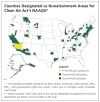Outdoor air pollutants and patient health
- PMID: 20082513
- PMCID: PMC4043261
Outdoor air pollutants and patient health
Abstract
Almost 160 million persons live in areas of the United States that exceed federal health-based air pollution standards. The two air pollutants that most commonly exceed standards are ozone and particulate matter. Ozone and particulate matter can harm anyone if levels are sufficiently elevated, but health risk from air pollution is greatest among vulnerable populations. Both ozone and particulate matter can cause pulmonary inflammation, decreased lung function, and exacerbation of asthma and chronic obstructive pulmonary disease. Particulate matter is also strongly associated with increased cardiovascular morbidity and mortality. Children, older adults, and other vulnerable persons may be sensitive to lower levels of air pollution. Persons who are aware of local air pollution levels, reported daily by the U.S. Environmental Protection Agency as the Air Quality Index, can take action to reduce exposure. These actions include simple measures to limit exertion and time spent outdoors when air pollution levels are highest, and to reduce the infiltration of outdoor air pollutants into indoor spaces.
Conflict of interest statement
Author disclosure: Dr. Laumbach has no conflicts of interest. He received funding from the National Institute of Environmental Health Sciences (NIEHS ES013520 and ES005022).
Figures

Summary for patients in
-
Patient information. Outdoor air pollution and your health.Am Fam Physician. 2010 Jan 15;81(2):181. Am Fam Physician. 2010. PMID: 20112457 No abstract available.
Similar articles
-
Patient information. Outdoor air pollution and your health.Am Fam Physician. 2010 Jan 15;81(2):181. Am Fam Physician. 2010. PMID: 20112457 No abstract available.
-
Particulate air pollution and cardiovascular disease--it is time to take it seriously.Rev Environ Health. 2014;29(1-2):129-32. doi: 10.1515/reveh-2014-0031. Rev Environ Health. 2014. PMID: 24552964
-
Association of Short-term Exposure to Air Pollution With Mortality in Older Adults.JAMA. 2017 Dec 26;318(24):2446-2456. doi: 10.1001/jama.2017.17923. JAMA. 2017. PMID: 29279932 Free PMC article.
-
Outdoor Air Pollution and Pediatric Respiratory Disease.Clin Chest Med. 2024 Sep;45(3):531-541. doi: 10.1016/j.ccm.2024.02.025. Clin Chest Med. 2024. PMID: 39069319 Review.
-
Health effects of outdoor air pollution. Committee of the Environmental and Occupational Health Assembly of the American Thoracic Society.Am J Respir Crit Care Med. 1996 Jan;153(1):3-50. doi: 10.1164/ajrccm.153.1.8542133. Am J Respir Crit Care Med. 1996. PMID: 8542133 Review.
Cited by
-
Employed adults with asthma who have frequent workplace exposures.J Asthma. 2015 Feb;52(1):46-51. doi: 10.3109/02770903.2014.944984. Epub 2014 Jul 29. J Asthma. 2015. PMID: 25029228 Free PMC article.
-
What can individuals do to reduce personal health risks from air pollution?J Thorac Dis. 2015 Jan;7(1):96-107. doi: 10.3978/j.issn.2072-1439.2014.12.21. J Thorac Dis. 2015. PMID: 25694820 Free PMC article. Review.
-
Monitoring intracellular redox changes in ozone-exposed airway epithelial cells.Environ Health Perspect. 2013 Mar;121(3):312-7. doi: 10.1289/ehp.1206039. Epub 2012 Dec 18. Environ Health Perspect. 2013. PMID: 23249900 Free PMC article.
-
Air pollution and refraining from visiting health facilities: a cross-sectional study of domestic migrants in China.BMC Public Health. 2022 Nov 2;22(1):2007. doi: 10.1186/s12889-022-14401-4. BMC Public Health. 2022. PMID: 36324110 Free PMC article.
-
Exposure to Air Pollution and Emergency Department Visits During the First Year of Life Among Preterm and Full-term Infants.JAMA Netw Open. 2023 Feb 1;6(2):e230262. doi: 10.1001/jamanetworkopen.2023.0262. JAMA Netw Open. 2023. PMID: 36811862 Free PMC article.
References
-
- U.S. Environmental Protection Agency. [Accessed October 29, 2009.];National air quality: status and trends through 2007. http://www.epa.gov/airtrends/2008/index.html.
-
- Environmental Protection Agency. [Accessed January 26, 2009.];Air Quality Index (AQI): a guide to air quality and your health. 2009 http://airnow.gov/index.cfm?action=aqibasics.aqi.
-
- American Academy of Family Physicians. [Accessed October 5, 2009.];Global warming and air pollution. AAFP policy and advocacy. 2005 http://www.aafp.org/online/en/home/policy/policies/g/globalwarming.html.
-
- Rabe KF, Hurd S, Anzueto A, et al. for the Global Initiative for Chronic Obstructive Lung Disease. Global strategy for the diagnosis, management, and prevention of chronic obstructive pulmonary disease: GOLD executive summary. Am J Respir Crit Care Med. 2007;176(6):532–555. - PubMed
Publication types
MeSH terms
Substances
Grants and funding
LinkOut - more resources
Full Text Sources
Medical

